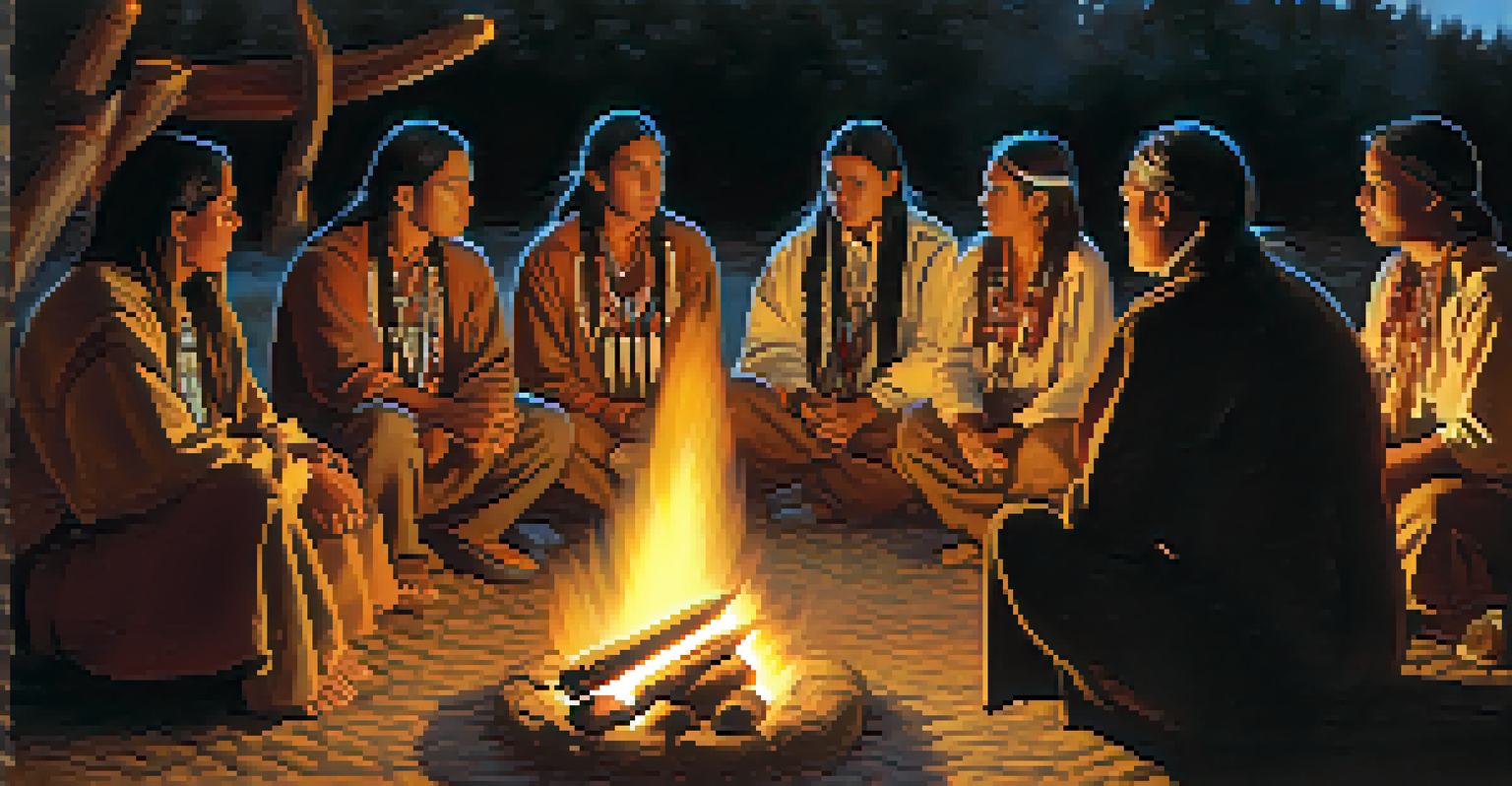Peyote and the Church: Legal Perspectives in the U.S.

Understanding Peyote: Cultural and Religious Significance
Peyote, a small cactus native to Mexico and the southwestern U.S., has been used for centuries in various indigenous cultures. For many Native American tribes, peyote is not just a plant; it's a sacred tool used in spiritual ceremonies and healing practices. Its psychoactive properties, primarily due to the compound mescaline, facilitate deep spiritual connections, making it an integral part of their religious identity.
The use of peyote is not only a means of spiritual exploration but also a profound cultural practice that embodies the identity of indigenous communities.
The use of peyote in religious contexts is deeply rooted in tradition, with ceremonies often focused on community, healing, and guidance. For example, the Native American Church incorporates peyote into its rituals, viewing it as a means to communicate with the divine. This cultural significance has prompted ongoing discussions about the legal status of peyote in the U.S., especially in relation to religious freedom.
As society becomes more aware of indigenous practices and their importance, understanding the cultural context of peyote is crucial. This awareness can lead to greater respect for religious freedoms and the unique traditions of Native Americans, emphasizing the need for legal recognition of peyote's role in their spiritual lives.
The Legal Landscape: Peyote and Federal Law
Under the Controlled Substances Act, peyote is classified as a Schedule I drug, meaning it is considered to have a high potential for abuse and no accepted medical use. This classification creates significant barriers for its use outside of recognized religious ceremonies. However, the legal framework has evolved, allowing some exceptions for Native American religious practices, which has spurred debate about broader access.

In 1978, the American Indian Religious Freedom Act was enacted, acknowledging the importance of peyote in Native American religions. This act aimed to protect the rights of indigenous peoples to practice their faith, including the use of peyote. Subsequent court rulings have reinforced these protections, allowing members of the Native American Church to use peyote without fear of legal repercussions.
Peyote's Cultural Importance
Peyote is a sacred plant for many Native American tribes, integral to their spiritual practices and identity.
Despite these protections, challenges remain. The intersection of federal law and state regulations can lead to confusion, particularly in states where marijuana has been legalized and attitudes towards psychoactive substances are changing. This complex legal landscape underscores the need for ongoing dialogue about religious freedom and drug policy in the U.S.
State Laws: Variations and Legal Challenges
While federal law provides a framework for peyote use in Native American religious practices, state laws can significantly vary. Some states have embraced the protections offered by the federal government, while others have remained more restrictive, complicating the legal landscape for practitioners. This patchwork of laws can create uncertainty for those wishing to use peyote for religious purposes.
Drug policy should not only consider the potential risks but also the cultural significance and religious freedoms that these substances represent.
For instance, in states like Arizona and New Mexico, peyote use is legally protected for Native Americans, reflecting a respect for indigenous traditions. However, in other states, the lack of clarity around legal protections can lead to arrests or legal action against individuals practicing their faith. These discrepancies highlight the need for a uniform approach that respects both state rights and religious freedoms.
Legal challenges often arise when individuals or groups push against these state laws, seeking to expand access to peyote for religious and spiritual use. These cases not only test the boundaries of existing laws but also bring attention to the broader conversation about drug policy and religious rights in America.
Peyote and the Supreme Court: Landmark Cases
The Supreme Court has played a pivotal role in shaping the legal landscape surrounding peyote use. One significant case is Employment Division v. Smith (1990), where the Court ruled that states can deny unemployment benefits to individuals fired for using peyote, even for religious reasons. This decision sparked widespread debate over the balance between religious freedom and drug laws, prompting calls for legislative changes.
In response to the Smith decision, Congress passed the Religious Freedom Restoration Act (RFRA) in 1993, seeking to protect religious practices from government interference. This act required the government to demonstrate a compelling interest before infringing on religious freedoms, although its application has been contentious in subsequent cases involving peyote and other substances.
Legal Challenges for Peyote Use
While federal laws provide some protections for peyote use in Native American ceremonies, state regulations can create confusion and legal risks.
More recent Supreme Court decisions continue to shape the discussion around peyote and religious use. These landmark cases not only influence legal interpretations but also reflect changing societal attitudes towards drug use and religious expression, highlighting the ongoing tension between law and spirituality in the U.S.
The Role of the Native American Church
The Native American Church (NAC) has been instrumental in advocating for the legal use of peyote in religious ceremonies. Founded in the early 20th century, the NAC blends traditional Native American beliefs with Christian elements, creating a unique spiritual framework that emphasizes the importance of peyote. This organization has played a crucial role in the fight for legal protections, representing the voices of indigenous peoples in legal and political arenas.
Through its advocacy efforts, the NAC has sought to educate the public and lawmakers about the spiritual significance of peyote. By sharing stories and experiences, they highlight how peyote ceremonies foster community, healing, and connection with the divine. This grassroots approach has been vital in shaping public perception and influencing policy decisions regarding peyote use.
In addition to advocating for legal rights, the NAC provides a supportive community for its members. This network not only offers spiritual guidance but also fosters a sense of belonging among individuals who share similar beliefs. The Church's ongoing efforts demonstrate the power of collective action in the pursuit of religious freedom and the preservation of cultural heritage.
Current Trends: Changing Attitudes Towards Psychedelics
As attitudes toward psychedelics shift in many parts of the country, the conversation around peyote is also evolving. Increasing interest in the therapeutic potential of psychedelics has led to a growing acceptance of their use in various contexts, including spiritual and religious practices. This change in perspective may pave the way for more comprehensive discussions about peyote and its role in indigenous spirituality.
Recent studies exploring the mental health benefits of psychedelics, including peyote, have garnered attention from both the scientific community and the public. As more people recognize the potential benefits of these substances, there is a renewed focus on the importance of preserving traditional practices and respecting indigenous rights. This trend could influence future legal frameworks surrounding peyote use.
Changing Attitudes Towards Psychedelics
Increasing interest in the therapeutic potential of psychedelics is prompting a reevaluation of peyote's role in indigenous spirituality and its legal status.
Moreover, the broader movement toward drug policy reform may create opportunities for changes in how peyote is regulated. As society becomes more attuned to the cultural and spiritual significance of peyote, there is potential for legal reforms that honor indigenous traditions while balancing public health considerations.
The Future of Peyote Use and Legal Rights
Looking ahead, the future of peyote use and legal rights remains uncertain but full of potential. As discussions around drug policy and religious freedoms continue, there is hope for more inclusive and respectful approaches to peyote use. Advocates for indigenous rights are working tirelessly to ensure that peyote remains accessible for spiritual practices, emphasizing its cultural significance.
Moreover, the increasing interest in psychedelics for therapeutic purposes could lead to a reevaluation of peyote's legal status. As more research highlights the benefits of these substances, policymakers may be more inclined to consider the unique role of peyote in Native American spirituality. This shift could foster greater understanding and collaboration between indigenous communities and lawmakers.

Ultimately, the journey towards securing legal rights for peyote use is a reflection of the ongoing struggle for indigenous recognition and respect. As society grapples with issues of spirituality, culture, and drug policy, the importance of listening to and valuing indigenous voices cannot be overstated. The future will depend on our collective commitment to honoring these traditions and ensuring that they are protected.